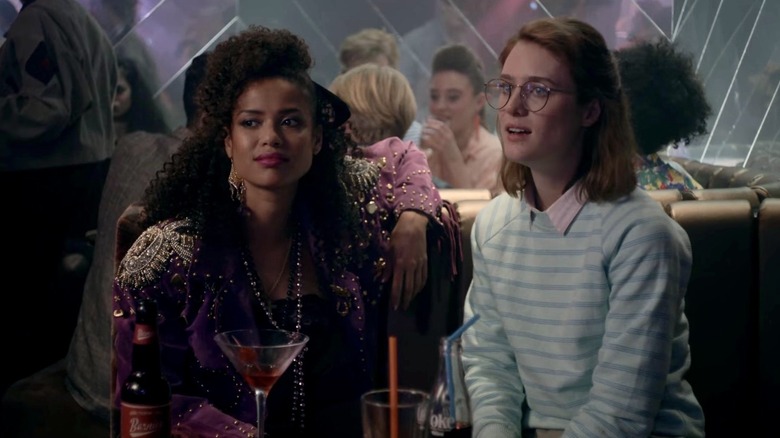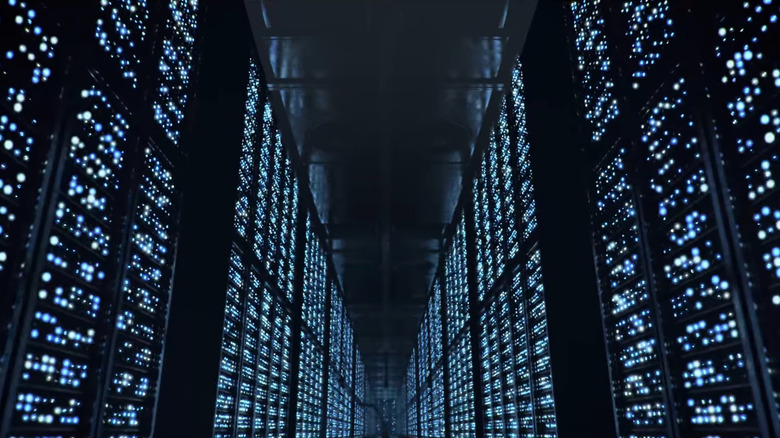Black Mirror's San Junipero Was Inspired By A Real-Life Type Of Therapy
This post contains spoilers for "Black Mirror" season 3, episode 4 "San Junipero."
Leave it to "Black Mirror" to make an episode involving euthanasia somehow hopeful. The Emmy-winning "San Junipero" has been hailed as "the show's finest hour" – it topped our ranking of episodes from the first three seasons of "Black Mirror" in 2016, and was again near the top in our updated ranking of all five seasons in 2022. Now, with "Black Mirror" season 6 on the way in June 2023, it's as good a time as any to go back, revisit old episodes, and perhaps wax nostalgic about the highs and lows of the series.
Consider it a form of "immersive nostalgia therapy," of the kind that Yorkie (Mackenzie Davis) and Kelly (Gugu Mbatha-Raw) undergo in "San Junipero." The episode is unique for "Black Mirror," not only because it's a love story with what could be interpreted as a happy ending, but because it's a period piece set partly in the 1980s. So much of "Black Mirror" operates on the bleeding edge of present and future technology, but in "San Junipero," we see two women meeting and falling in love in a California seaside resort town where the '80s come alive in old-fashioned arcade games and era-appropriate pop songs like Belinda Carlisle's "Heaven Is a Place on Earth."
In a 2016 interview with IndieWire, "Black Mirror" series creator Charlie Brooker explained that the idea for the episode originated from his desire to shake up the "Black Mirror" formula. "It came about," Brooker said, "because I thought that's not what people would expect to see when they switch on a new episode of 'Black Mirror.' They expect to see somebody frowning at an iPhone or something. So having it open in 1987 in California seemed like a good idea."
The elderly 'in a room decorated like the 1940s'
In "San Junipero," the technological twist comes when it's revealed that the episode's 1980s period setting exists within a simulated reality that uploads people's consciousness into a kind of digital afterlife in a glittering server room. Even before they die, the elderly go there to experience nostalgia therapy. As the elder Kelly (Denise Burse) explains in the real world, the idea is to "plunge you into a world of memories" in a way that "helps with Alzheimer's" disease.
As it turns out, nostalgia therapy is a real thing. Whereas "Black Mirror" stories usually proceed from "a human dilemma or a 'what if,'" according to Charlie Brooker, "San Junipero" combined his desire to do a period piece with his interest in a genuine form of treatment that can put people in a scenario like the time-displaced Steve Rogers at the end of "Captain America: The First Avenger:"
"I think we'd seen a documentary about it — it's a thing that has been done where they'll take old people and put them in a room decorated like the 1940s or something, and they're almost physically rejuvenated by the experience. So it came about by talking about both those things, and then a sort of story emerged from it."
Months before "San Junipero" hit Netflix, "Stranger Things" premiered on the same streamer, bringing a heavy dose of '80s nostalgia to viewers. Since then, pop culture has been overrun all the more by nostalgia, with the legacy-sequel phenomenon becoming more popular and film franchises mining the past for old glories amid a future that looks bleaker and more "Black Mirror"-like by the day. As one such legacy sequel, "The Matrix Resurrections," put it: "Nothing comforts anxiety like a little nostalgia."
"Black Mirror" is streaming on Netflix.

